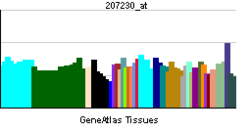CDON
| View/Edit Human | View/Edit Mouse |
Cell adhesion molecule-related/down-regulated by oncogenes is a protein that in humans is encoded by the CDON gene.[4][5]
CDON and BOC (MIM 608708) are cell surface receptors of the immunoglobulin (Ig)/fibronectin type III (FNIII; see MIM 135600) repeat family involved in myogenic differentiation. CDON and BOC are coexpressed during development, form complexes with each other in a cis fashion, and are related to each other in their ectodomains, but each has a unique long cytoplasmic tail.[supplied by OMIM][5]
Interactions
CDON has been shown to interact with CDH1[6] and BOC.[7]
References
- ↑ "Diseases that are genetically associated with CDON view/edit references on wikidata".
- ↑ "Human PubMed Reference:".
- ↑ "Mouse PubMed Reference:".
- ↑ Kang JS, Gao M, Feinleib JL, Cotter PD, Guadagno SN, Krauss RS (Aug 1997). "CDO: An Oncogene-, Serum-, and Anchorage-regulated Member of the Ig/Fibronectin Type III Repeat Family". J Cell Biol. 138 (1): 203–13. doi:10.1083/jcb.138.1.203. PMC 2139939
 . PMID 9214393.
. PMID 9214393. - 1 2 "Entrez Gene: CDON Cdon homolog (mouse)".
- ↑ Kang, Jong-Sun; Feinleib Jessica L; Knox Sarah; Ketteringham Michael A; Krauss Robert S (Apr 2003). "Promyogenic members of the Ig and cadherin families associate to positively regulate differentiation". Proc. Natl. Acad. Sci. U.S.A. United States. 100 (7): 3989–94. doi:10.1073/pnas.0736565100. ISSN 0027-8424. PMC 153035
 . PMID 12634428.
. PMID 12634428. - ↑ Kang, Jong-Sun; Mulieri Philip J; Hu Yulan; Taliana Lavinia; Krauss Robert S (Jan 2002). "BOC, an Ig superfamily member, associates with CDO to positively regulate myogenic differentiation". EMBO J. England. 21 (1–2): 114–24. doi:10.1093/emboj/21.1.114. ISSN 0261-4189. PMC 125805
 . PMID 11782431.
. PMID 11782431.
Further reading
- Gerhard DS, Wagner L, Feingold EA, et al. (2004). "The Status, Quality, and Expansion of the NIH Full-Length cDNA Project: The Mammalian Gene Collection (MGC)". Genome Res. 14 (10B): 2121–7. doi:10.1101/gr.2596504. PMC 528928
 . PMID 15489334.
. PMID 15489334. - Ota T, Suzuki Y, Nishikawa T, et al. (2004). "Complete sequencing and characterization of 21,243 full-length human cDNAs". Nat. Genet. 36 (1): 40–5. doi:10.1038/ng1285. PMID 14702039.
- Wegorzewska M, Krauss RS, Kang JS (2003). "Overexpression of the immunoglobulin superfamily members CDO and BOC enhances differentiation of the human rhabdomyosarcoma cell line RD". Mol. Carcinog. 37 (1): 1–4. doi:10.1002/mc.10121. PMID 12720294.
- Kang JS, Feinleib JL, Knox S, et al. (2003). "Promyogenic members of the Ig and cadherin families associate to positively regulate differentiation". Proc. Natl. Acad. Sci. U.S.A. 100 (7): 3989–94. doi:10.1073/pnas.0736565100. PMC 153035
 . PMID 12634428.
. PMID 12634428. - Cole F, Krauss RS (2003). "Microform holoprosencephaly in mice that lack the Ig superfamily member Cdon". Curr. Biol. 13 (5): 411–5. doi:10.1016/S0960-9822(03)00088-5. PMID 12620190.
- Strausberg RL, Feingold EA, Grouse LH, et al. (2003). "Generation and initial analysis of more than 15,000 full-length human and mouse cDNA sequences". Proc. Natl. Acad. Sci. U.S.A. 99 (26): 16899–903. doi:10.1073/pnas.242603899. PMC 139241
 . PMID 12477932.
. PMID 12477932. - Kang JS, Mulieri PJ, Hu Y, et al. (2002). "BOC, an Ig superfamily member, associates with CDO to positively regulate myogenic differentiation". EMBO J. 21 (1–2): 114–24. doi:10.1093/emboj/21.1.114. PMC 125805
 . PMID 11782431.
. PMID 11782431.
This article is issued from Wikipedia - version of the 6/6/2016. The text is available under the Creative Commons Attribution/Share Alike but additional terms may apply for the media files.

